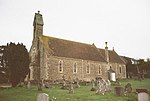Margaret Marsh
Civil parishes in DorsetDorset geography stubsHamlets in Dorset

Margaret Marsh is a hamlet and civil parish in north Dorset, England. It is situated in the Blackmore Vale, halfway between the towns of Shaftesbury and Sturminster Newton. It is sited on Kimmeridge Clay close to a small tributary stream of the River Stour. In the 2001 census the parish had a population of 60. In 2013 the estimated population of the parish was 40. The parish church has a 15th-century tower and 13th-century font, but the rest of the building was rebuilt in 1873. For local government purposes the parish is grouped with the parishes of East Orchard and West Orchard, to form a Group Parish Council.
Excerpt from the Wikipedia article Margaret Marsh (License: CC BY-SA 3.0, Authors, Images).Margaret Marsh
Church Lane,
Geographical coordinates (GPS) Address Nearby Places Show on map
Geographical coordinates (GPS)
| Latitude | Longitude |
|---|---|
| N 50.9674 ° | E -2.2521 ° |
Address
Church Lane
Church Lane
SP7 0AZ , Margaret Marsh
England, United Kingdom
Open on Google Maps











